Our history
We proudly bear the name of our founder, Mr. Heikki Huhtamäki. Young Heikki, a village baker's son, established Huhtamäki Industries in 1920 in Kokkola, Finland. Ever since then, we've followed his spirit of adventure in exploring new opportunities across the world.

A hundred years ago, the disposable income of Finnish people had risen considerably, thanks to the economic growth stemming from the lumber industry. It was then that a young and visionary man called Heikki Huhtamäki got an idea. He traveled to Russia to learn the secrets of confectionery. Inspired by this journey, in 1920, Huhtamäki founded a candy factory in an old barn located in rural Western Finland.
In the beginning O/Y Huhtamäen Tehtaat – A/B Huhtamäkis Fabriker made 46 different types of candy mostly by hand and produced wooden boxes and containers for these delicacies. The start was ambitious, as 61 people were hired to work in the factory during the first year. Encouraged by the increased purchasing power of the Finns, the factory was expanded, and a sales office was opened in Helsinki in 1921.
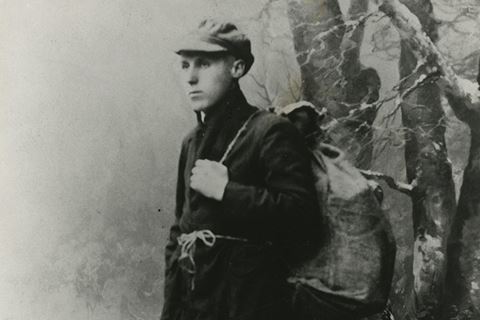
16-year-old Heikki Huhtamäki on his eastern adventure that inspired him to soon start his own confectionery business.
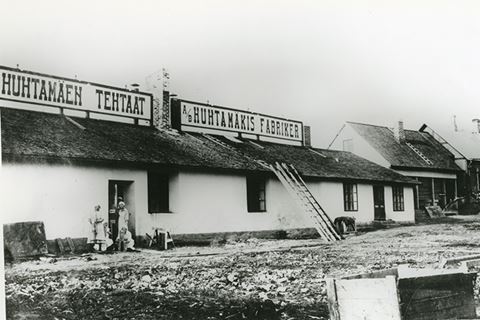
In 1920, Heikki Huhtamäki opened the first factory in a stone barn located in Savela, a small village in rural Western Finland.
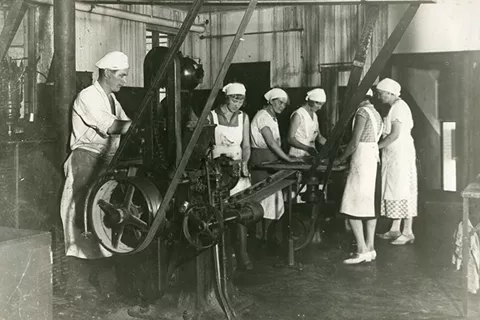
Production of chocolate bars was partly teamwork and partly aided by machines.

The effects of the Great Depression reached Finland, causing economic difficulties also for Huhtamäki. However, merging with Hellas, another confectionary manufacturer, in 1932, saved the company for the time being.
Heikki Huhtamäki wanted to broaden his horizons also to other areas of the food industry. This led to a surprising move: he resigned as the CEO of Huhtamäki, sold his shares and leaped to Ipnos, an industrial bakery, with some trusted fellows. Under his leadership, Ipnos expanded its offering from bread to confectionery – growing to compete with Huhtamäki-Hellas. Being part of the management of Jalostaja, which focused on preserving garden harvest, further increased Heikki’s influence in the food industry.
After a series of events, Heikki assembled his assets and bought back Huhtamäki-Hellas. Now, all his businesses were under the same roof.
The 1930s marked the diversification of the company offering from candy to other food products, while packaging of the articles continued to be important.
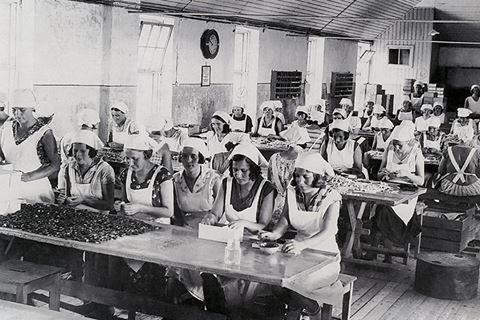
In the early days, making candy required much handcraft. Here, ladies are working at the production line of Hellas.

Heikki Huhtamäki broadened his horizons to Ipnos, a bread factory, which started with the production of crispbread.
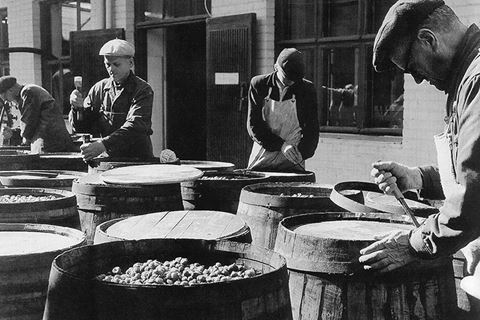
Jalostaja wanted to make it possible to eat domestic fruits, berries and vegetables all year round. It further diversified the food portfolio of Huhtamäki.
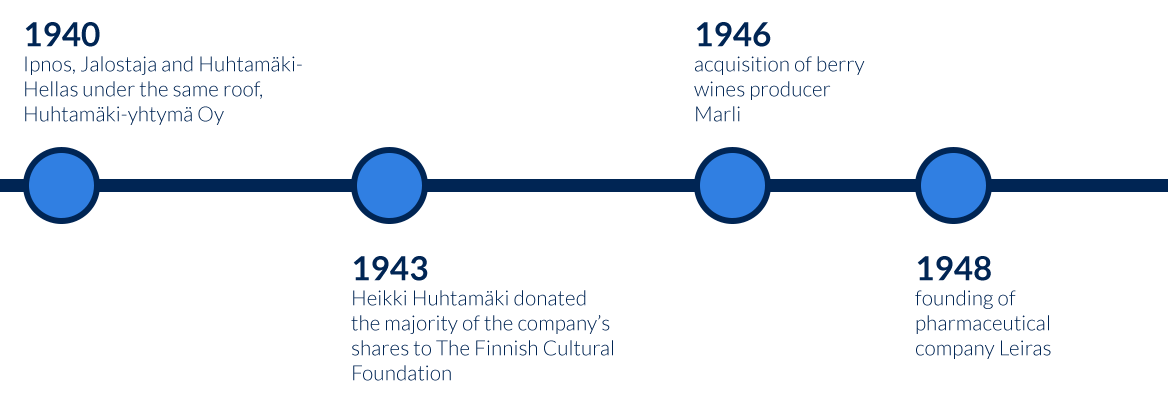
In 1940, Heikki Huhtamäki gathered all his holdings under the name Huhtamäki-yhtymä Oy. The times were tough, as the world was at war. Rationing and the lack of raw materials set special demands for the business. Ipnos, for example, supplied the army with cereal products and Hellas concentrated on innovating substitutes.
Heikki became worried about the continuity of the company and found donating the majority of the company shares to the Finnish Cultural Foundation the best solution. This did not, however, mean his withdrawal from leading the company.
The wellbeing of employees was also a central topic of interest for Huhtamäki, and in the mid-40s, the company took concrete steps to improve, for example, maternity and retirement benefits. The focus on these questions extended to the core business as well: the pharmaceutical company Leiras was founded in 1948. The decade saw the further expansion of Huhtamäki’s portfolio, not only in terms of food but also health care products.
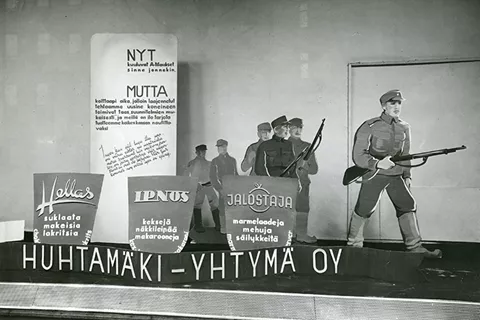
The war drove Huhtamäki to supply the army with food and develop substitutes. Yet, optimism about the future prevailed.
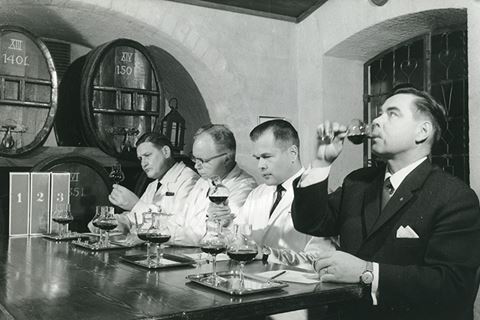
Men at Marli developing recipes for berry wines and liqueurs.
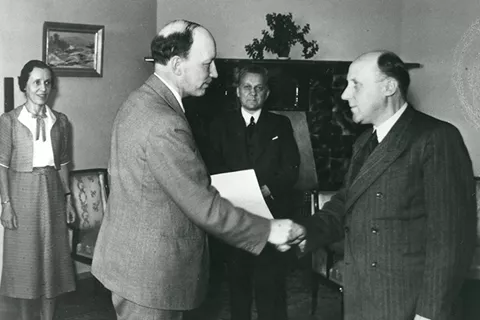
Huhtamäki handing over the majority of shares to the Finnish Cultural Foundation was an important topic of discussion back in the 1940s.

After times of scarcity, people were thrilled to experience increased consumer opportunities. As Huhtamäki was already operating in the pharmaceutical industry, the company could smoothly diversify further into the production of cosmetics, leading to the establishment of Fincos in 1954. Consumers welcomed these everyday luxuries as foreign imports were still limited. Although Huhtamäki diversified its offering somewhat in the fifties, this period was mostly directed towards internal development, for example, through improvements in expertise and investments in production lines. At the same time, external relationships with clients and the general public were strengthened to build up goodwill.
In 1959, Huhtamäki was listed in the Helsinki Stock Exchange. At the time, affordable liabilities remained the main source of capital, while the exchange facilitated establishing beneficial public relations.
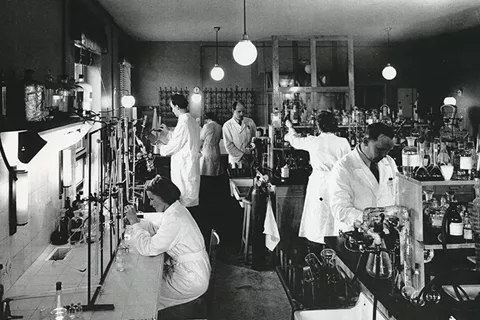
With Leiras, Huhtamäki had broadened its offering to pharmaceuticals. Here, employees are developing new medicines.

Spreading the joy through sweets at a public event in the 1950s.

Huhtamäki entered the cosmetics industry with Fincos. It was a natural continuum for a company that already produced pharmaceuticals.

1960s was characterized by the rise of youth counterculture and revolution of social norms. Leiras got a hold of this trend with the launch of contraception pills, which helped them to rise to be the second largest pharmaceutical manufacturer in Finland. Not to forget that also Marli – a berry wine and liqueur producer – and Hellas were among the market leaders in their fields.
With the acquisition of Mensa, a meat processor who had its own canning line, Huhtamäki remarkably strengthened its position in the packaging industry. This marked a critical new strategic direction. Finally, with the establishment of the business line for packaging, Polarpak, packaging evolved from a supporting in-house function into a distinct business line in 1965.

Huhtamäki dedicated an entire business line to packaging. Polarpak’s production line in action.
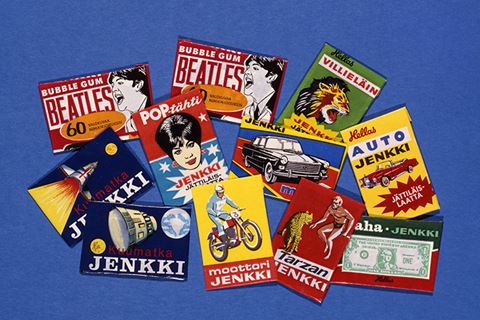
Chewing gum wrappers mirrored the times, featuring youth culture idols and space voyages. People enjoyed their newfound freedom.
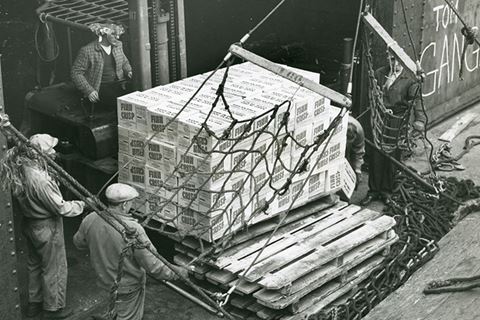
Little by little, exports started to rise in importance. Finnish crispbread being shipped to Macy’s department store in New York.

During the seventies, Huhtamäki-yhtymä Oy was a huge conglomerate, which operated in almost 20 unrelated businesses ranging from clothing to pipes. This was a phase of finding a direction, as many acquisitions were made but none of them remained permanently within the organization, whose name was shortened to Huhtamäki Oy in 1975.
Huhtamäki redefined the company purpose from generally “satisfying consumer needs” to capitalistically generating a “competitive return on invested capital” – while still fulfilling the “reasonable expectations” of employees and other stakeholders. A way to support this chosen direction was to focus on exports, since Finnish demand was stagnating, affected by competition from imports. Eastern trade, which culminated in supplying disposables for the Moscow Olympics, was given considerable attention due to the political climate of the time. It set the stage for heading west and Polarpak becoming the leading paper cup manufacturer in Europe.
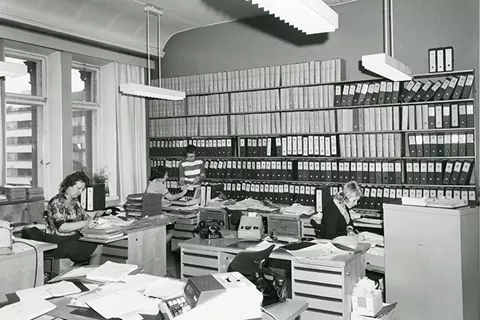
The accounting department handled over 60 000 invoices in 1972.
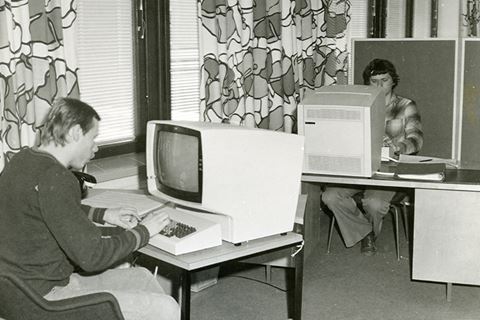
Huhtamäki kept up to date with the times. The computing department had modern equipment considering the standards of the decade.
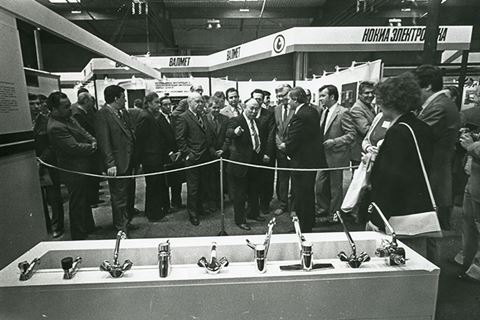
At its most diverse stage, Huhtamäki operated in about 20 unrelated businesses, offering even faucets.

The golden days of yuppies and the economic upswing formed a great setting for growing the business. Huhtamäki exceeded its targets in terms of exports, although the company’s roots were still tightly in Finland.
By now, it had become clear that ambiguous expansion to different industries was not the best option. Hence, a new strategy was adopted, guiding the company towards concentration and internationalization. The novel strategic intent was to become the world leader by the turn of the millennium.
This task got off to a good start with the purchase of a group of American confectionary companies, which were gathered under the name Leaf. This foreign acquisition was the biggest in Finland at the time and nearly doubled the turnover of Huhtamäki.
While confectionery still held an important position, packaging was also going forward: the division was renamed Polarcup and, through the acquisition of Bellaplast, rose to be among the biggest players of the industry in Europe. As fast food culture gained a foothold in Europe, there was a need for packaging solutions.
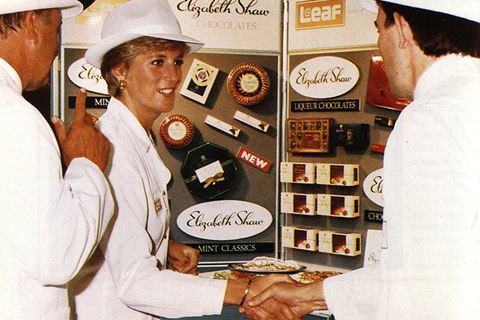
Internationalization became one of the company’s strategic objectives. Huhtamäki was honored to supply even the British royal family.
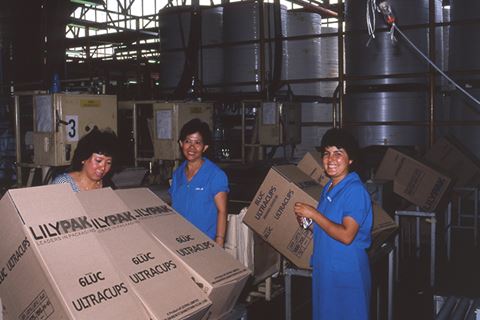
The packaging division had grown through acquisitions and was now named Polarcup. Happy workers in the New Zealand factory.

The good times ended in the early 1990s as Finland encountered a deep depression. Yet, later, Finland’s membership in the European Union opened up new avenues for business.
At the beginning of the decade, Huhtamaki operated in three main business areas: confectionery, pharmaceuticals and packaging. Nevertheless, it had turned out that packaging was strategically best positioned. For instance, Polarcup was visibly present when Coca-Cola was enjoyed at the Barcelona Olympics and new “bioplastics” were tested in the passenger trains of VR, the government-owned railway company in Finland.
Huhtamaki was now the market leader in food packaging and disposable tableware both in Europe and Asia Pacific. It was then decided that other business areas would be divested, and all efforts were directed into this one field.
Aiming for the top, Huhtamaki acquired 14 packaging competitors, with the most important acquisitions being the US-based Sealright in 1998 and Dutch Van Leer in 1999. The name of the company was changed to Huhtamaki Van Leer, and packaging became the company’s single operational area.

Huhtamaki found its core operational area in packaging. Disposable tableware was among the top products.

More attention was gradually paid to environmental issues. Huhtamaki supplied VR passenger trains with cups that were coated with “bioplastics”.

As the market leader in packaging and disposable tableware, Huhtamaki decided to concentrate solely in this area and acquired important competitors such as Van Leer.

The arrival of the new millennium gave a reason to celebrate. On one hand, the economy was healthier after the hard times, but on the other hand, concerns about the climate change increased.
Huhtamaki wanted to further concentrate its business. The industrial packaging section stemming from Van Leer was sold in 2001, which transformed Huhtamaki into a pure consumer packaging company. Simultaneously, the name was changed back to Huhtamäki Oyj.
The rising demand drove the company to increase the production capacity internationally, not only in existing factories but also by opening new manufacturing plants. In 2008, the group updated the strategic direction. It meant that Huhtamaki increased the focus on growing molded fiber products, flexible, and foodservice packaging.

Continuing on the path of concentration, Huhtamaki chose to solely focus on consumer packaging.
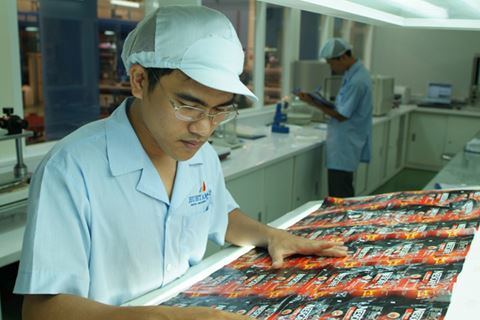
The rising demand drove the company to increase the production capacity internationally.

The operational environment has become more complex, volatile and more international than ever before. The world’s population is increasing, the middle class has more available income and the number of people living in cities is growing. Huhtamaki operates in all continents and packaging for food and drink is at the center of the company strategy.
During the 2010s, Huhtamaki expanded its portfolio by acquiring folded carton capability and strengthened its footprint in emerging markets. The business in North America has transformed by growing in retail private label tableware and expanding foodservice portfolio.
Growth was the prevailing tone of the past decade. Innovation and employee wellbeing continue to be crucial for Huhtamaki’s growth. Today, sustainability has earned Huhtamaki’s attention and the company offers more and more recyclable products and products made of renewable raw materials.

Huhtamaki's corporate responsibility program, Packaging for Good, focuses on four themes; People, Packaging, Supply chain and Operations.

The rising environmental consciousness of consumers has led Huhtamaki to develop more ecological disposables.
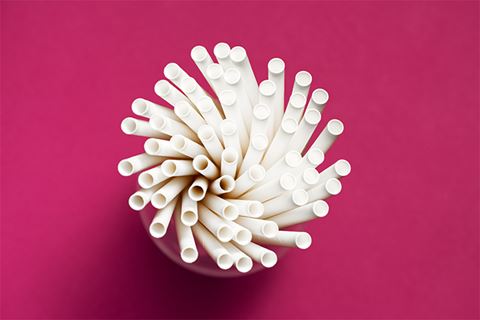
New ideas are needed to respond to changing consumer needs. Huhtamaki people innovate packaging solutions for the future.

In recent years, Huhtamaki has hit record results. Also, the company has been internationally awarded.

In 2020, we launched our 2030 strategy, highlighting our mission to protect food, people, and the planet.
Sustainability become a stronger area of focus, embedded in our vision of becoming the first choice in sustainable packaging solutions. In this, we continue to be guided by our values Care, Dare, and Deliver.




